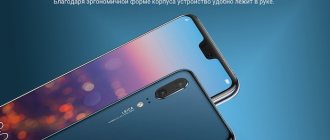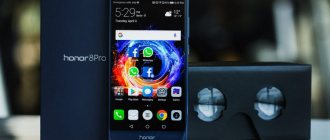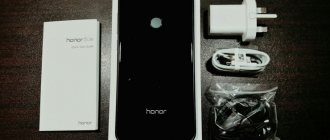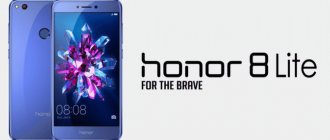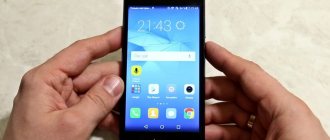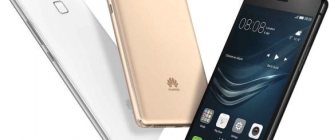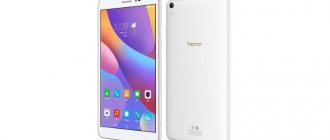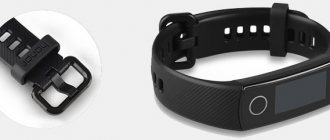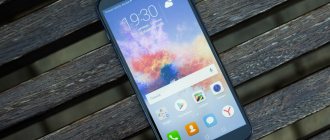Appearance
I wonder what impression the Honor 6 makes on outsiders. "ABOUT! It’s an iPhone!” I heard more than once. I don’t know whether the manufacturer’s goal was to bring the appearance of these devices as close as possible, but he definitely succeeded. The device really, with its shape and metallic edging, is very reminiscent of the fourth generation iPhone. Even the camera with the same chrome hoop is in the same place. How can such parallels not arise here?
On the front side there is a screen, which is covered with a protective glass panel with an oleophobic coating. The frames around the display are 2.86 mm thick (yes, we have everything exactly), so nothing is annoying and everything is as convenient as possible: there are no accidental clicks.
Above the screen there is a speaker grid, a light and proximity sensor hole and, of course, the front camera, but below there is complete emptiness. Due to the transfer of touch keys to the display, the smartphone is conveniently held in a horizontal orientation. Fans of portable movies and games will definitely appreciate it.
There's nothing on the left side, so let's move on. On the right side there are all the controls: the volume and power keys, as well as plastic plugs, under which the slot for the SIM card and microSD card is hidden.
Why the plugs were used here is unknown, since the smartphone is afraid of dust and water as well as fire.
The bottom end is “rich” only with a microphone hole and a microUSB connector in the center. On the top side we can see another microphone hole, an infrared port for controlling household appliances and a regular audio output.
The main speaker of the device is located on the back side, which can lead to slight muffling of the sound if the device is lying face up. All elements on the back side are made flush, so the device lays flat on any smooth surface.
The back cover is made of an unknown material, reminiscent of somewhat soft, glossy plastic. The guys from Huawei explain that the back cover is a real pie made of six composite materials used in astronautics. Nothing more is specified. In practice, at certain angles, you can see a circular pattern in the depths of the dark surface. This is not immediately noticeable, so there is no need to talk about any additional wow effect.
In addition, unfortunately, the back cover very quickly becomes covered with scratches of various sizes.
I tried to reflect this in the photo. It seems that in order for the smartphone not to turn into a devil with horns after a year of use, it will be necessary to store it in some kind of case. There is another alternative: purchase a white model. Most likely, on white the grid of small scratches will not be so noticeable.
Now about the dimensions of the smartphone. It lies securely in your hand, does not slip out and is not prone to falling. The dimensions of the case are average, so the device is very easy to handle. The numbers will tell you more about all this.
| Length | Width | Thickness | Weight | |
| Huawei Honor 6 | 139,6 | 69,7 | 7,5 | 130 |
| Samsung Galaxy Alpha | 132,4 | 65,5 | 6,7 | 115 |
| iPhone 5S | 123,8 | 58,6 | 7,6 | 112 |
| Sony Xperia Z3 Compact | 127 | 64,9 | 8,6 | 129 |
| Apple iPhone 6 | 138,1 | 67 | 6,9 | 129 |
| Samsung Galaxy S5 | 142 | 72,5 | 8,1 | 145 |
Design
Huawei Honor 6 32gb review will introduce you to the appearance of the device, which in its style is very close to the Ascend P7. The manufacturer decided to abandon the use of metal ends in an attempt to save money by offering cheaper plastic. In this regard, the new model looks less impressive. The case is manufactured using a non-standard finish that includes six layers. It increases the transparency of the material, but at the same time the special structure does not allow the case to collect fingerprints. In the version with a white body, it is almost impossible to see fingerprints.
Due to the narrow frames around the display, the body dimensions are comparable to the 4.7-inch iPhone 6, despite the fact that the Huawei Honor 6 16 GB has a larger diagonal. The review shows that the device turned out to be comfortable. It is compact and fits well in the hand. The display occupies over 75% of the front panel.
The lock key and volume rocker are located on the right side. There are also two slots for SIM cards and microSD. Unfortunately, there is no support for two SIM cards.
On the top edge there is a 3.5 jack for a headset, and next to it is an IR port. The latter expands the functionality, opening up rich opportunities for managing home appliances.
The back side is designed in the usual style for the manufacturer - a camera, dual LED backlight, and a multimedia speaker.
Our Huawei Honor 6 plus 32gb review shows that the smartphone looks excellent, which is achieved by the use of glass in the manufacture of the back cover, rounded ends and small thickness - only 7.5 mm.
Display
The screen is made using IN-CELL technology and covered with protective glass Corning Gorilla Glass 3. It is based on an IPS matrix.
A diagonal of five inches is the golden mean of convenience: the image is not small, but you can use the device quite comfortably. The use of Full HD resolution with 445 pixels per square inch is fully justified. There is no point in installing a panel with a higher pixel density. All fonts and rounded icons look very smooth and beautiful, so the appearance of the shell does not suffer at all.
The depth of colors, richness of colors, viewing angles pass all the highest selection criteria.
For clarity, I recommend paying attention to the comparison of the screen of the hero of today’s article with the display installed in the Samsung GALAXY Note 4 (pictured above).
Please note that from an angle the picture on Honor 6 looks even better: colors are not distorted and criminal greenish tints do not appear. And all this in a device that costs more than half the price of the flagship from the Korean giant.
If suddenly for some reason the color temperature of the screen does not suit you, you can adjust it from the settings.
Screen
Huawei Honor 6 has a 5-inch screen with Full HD resolution of 1920×1080 pixels, a pixel density of 440 ppi and an IPS touch matrix.
Multi-touch technology processes up to 10 simultaneous touches. There is a proximity sensor that locks the screen when you bring the smartphone to your ear.
The display brightness can be set manually, or you can trust the auto-tuning, which is quite adequate.
The screen has a good anti-glare coating and high maximum brightness, so there should be no problems when reading messages from the screen on a bright sunny day.
In addition to anti-glare, the Honor 6 display has an oleophobic coating, thanks to which fewer fingerprints remain on the surface and they are erased quite easily.
Technical characteristics of Huawei Honor 6 (H60-L04):
- Hi-Silicon Kirin 920 processor
- Mali T628 video chip
- RAM 3 GB (on a “bare” system 1941 MB is actually available)
- 16 GB data storage memory (10.69 GB available)
- memory card support (microSD up to 32 GB)
- display 5'', 1920 x 1080 pixels (445 ppi)
- battery 3000 mAh
- Sensors: accelerometer, light sensor, proximity sensor,
- compass, gyroscope
- ports: 3.5 mm audio output, microUSB 2.0 (OTG)
- OS: Android 4.4.2
- Shell version, EmotioinUI 2.3
- Dimensions 139.6 x 69.7 x 7.5 mm
- Weight 130 g
Networks:
- 2G (850/900/1800/1900 MHz), 3G (DC-HSPA+), 4G
- Wi-Fi (IEEE 802.11 b/g/n), Bluetooth 4.0, FM radio
- NFC is missing
- aGPS / GLONASS
- infrared port
And now more about hardware, fortunately, there is something to talk about. The processor is the brainchild of the fifth generation of chips from HiSilicon and is built using 28-nanometer technology on the big.LITTLE architecture. Four Cortex-A7 cores operate at 1.3 GHz, and 4 others (Cortex-A15) at 1.7 GHz. In general, eight cores are used, and very efficiently.
There are as many as three gigabytes of RAM installed here - how do you like this in a smartphone under 20,000 rubles? Dual-channel memory (LPDDR3) operates at a frequency of 800 MHz.
In advertising and press releases, the manufacturer focuses on the installed LTE cat 6 module, which supports both FDD bands: 1, 3, 7, 20, and TDD 38. Due to all this, a record speed of up to 300 Mbit/s is achieved.
So the smartphone has a very serious foundation for the future. It can remain relevant for quite a long time not only due to its iron insides, but also thanks to its network capabilities.
However, speaking about the latter, there is one disappointment.
The smartphone does not support NFC.
Apparently, one of the largest Chinese manufacturers simply does not like this communication standard. Well, I don’t like it, that’s all. What other logical explanation could there be?
In nature there is also a version with two SIM cards on board. In this case, support for memory cards does not disappear anywhere. A hole for a flash card is added directly under the slot of one of the SIM cards.
Detailed technical specifications
Make and model
Make and model of the device, and alternative names (if any).
| Brand Device manufacturer company. | Huawei |
| Model Device name. | Honor 6 |
| Alternative names Other model names, if available. Sometimes the model is called differently, depending on the country or because of popular nicknames. | Glory 6 Mulan H60-L01 H60-L02 H60-L04 H60-L11 H60-L12 |
Design
Appearance of the device including dimensions, weight, volume, colors and materials.
| Width The horizontal side of the device when used in standard orientation. | 69.7 mm (millimeters) |
| Height The vertical side of the device when used in standard orientation. | 139.6 mm (millimeters) |
| Thickness The cross-sectional size of the device. | 7.5 mm (millimeters) |
| Weight How much does the device weigh excluding the case, SIM and memory cards and other additional elements. | 130 g (grams) |
| Volume Approximate value calculated using the formula: length times width times height. | 72.98 cm³ (cubic centimeters) |
| Colors What colors is the device available in? | Black White |
| Housing materials What materials is the body made of? | Aluminum alloy Glass |
System on a Chip (SoC)
A system on a chip, a single-chip system (System on a Chip, SoC) is when several systems performing different device functions are connected on one chip.
| System on a Chip (SoC) A single-chip system that contains components such as a processor, graphics accelerator, memory units, communication interfaces, etc., as well as software for the operation of the system. | Huawei HiSilicon KIRIN 920 |
Central processing unit (CPU)
| Central processing unit (CPU) The main component of the device is responsible for calculations and data processing. | 4x 1.7 GHz ARM Cortex-A15, 4x 1.3 GHz ARM Cortex-A7 |
| Technical process What technological process is used to make the chip? The smaller the process technology, the better - the chips consume less power and generate less heat. | 28 nm (nanometers) |
| Processor size Processor capacity is a parameter that indicates how many bits of data a processor register processes in 1 clock cycle. This is usually 32 or 64 bits. | 32 bit |
| Instruction Set Architecture Instruction set architecture (ISA) is a programmable part of the microprocessor core used by software to control the operation of the processor. | ARMv7 |
| Number of processor cores The processor can be either single-core or multi-core. The performance of the processor depends on the number of cores (threads). The more cores working simultaneously, the higher the power consumption, so in mobile devices all cores are used only under high load. | 8 |
| CPU clock speed Clock speed is the number of operations per second that a processor or its core can achieve. The higher the frequency, the higher the overall performance of the device, but performance also depends on the processor architecture and the number of cores. | 1700 MHz (megahertz) |
Graphics Processing Unit (GPU)
| Graphics Processing Unit (GPU) The graphics processing unit (GPU) is used to process and display graphics - 3D effects, games, interfaces and other visual elements. Due to the pipeline architecture, the GPU is many times more efficient in graphics processing than the processor. | ARM Mali-T628 MP4 |
| Number of GPU cores Similar to a processor, a GPU can have one core or several. The number of cores (threads) determines the performance and amount of information processed. The more cores, the better. | 4 |
| GPU clock speed Clock speed is the number of operations per second that the GPU or its core is capable of achieving. The higher the frequency, the higher the speed of the processor, and therefore the number of tasks it can solve. | 600 MHz (megahertz) |
Random access memory (RAM)
| Amount of random access memory (RAM) RAM (Random Access Memory, RAM, RAM) is temporary memory (works only while the device is running), which stores data and code for the operational operation of programs and applications. The more RAM, the more programs you can run simultaneously without loss of performance (there will be fewer “brakes”). | 3 GB (gigabytes) |
| Type of random access memory (RAM) Information about the type of RAM used by the device. | LPDDR3 |
| Number of RAM channels 1 is a single-channel RAM operating mode, basic, when 1 memory module is used. 2 is already a two-channel mode - a mode of parallel operation of 2 modules or pairs of modules, memory channels - this mode is 2 times faster than a single-channel one. 3 – three-channel mode is 3 times faster than single-channel mode. | Dual channel |
| RAM frequency The frequency of RAM determines the speed of RAM, or rather the speed of data transfer and reception. In theory, the higher the frequency, the more powerful the RAM. | 800 MHz (megahertz) |
Built-in memory
Most mobile devices have built-in Flash memory, which is used as a storage for system data, the operating system, as well as user data - photos, videos, recordings and much more.
| Built-in memory capacity The higher the amount of built-in memory, the more games, programs, music, videos and your other files will fit in the device, especially the amount of memory is important when the device does not support memory cards. | 16 GB (gigabytes) 32 GB (gigabytes) —- eMMC |
Operating system
A mobile operating system (OS) is pre-installed software with a well-thought-out interface for user control of device functions.
| Operating system (OS) The operating system installed by default by the device manufacturer, as well as its version. | Android 4.4.2 KitKat Android 5.1.1 Lollipop |
| User interface User interface (UI - user interface) is usually a graphical shell that ensures the transfer of information between the user and the operating system. | Emotion 3.0 Emotion 3.1 |
Battery
To operate autonomously, a mobile device requires a battery that powers all its components.
| Battery capacity The main characteristic of a battery is its maximum capacity, that is, the charge it can store. Capacity is measured in mAh (mAh, milliamp-hour). The higher the capacity, the longer the mobile device can work. | 3100 mAh (milliamp-hours) |
| Battery type Many types of batteries have been used in portable devices, but NiCd (nickel-cadmium), NiMH (nickel-metal hydride), and even more so SLA (lead-acid) batteries are already considered obsolete. Instead, modern mobile devices use Li-Ion (lithium-ion) and Li-Pol, Li-Poly (lithium-polymer) batteries. | Li-polymer |
Screen
The screen (display) is the main element for displaying graphic information.
| Technology The technology used to make the screen. There are many types of display manufacturing with their pros and cons. | JDI IPS |
| Diagonal The screen diagonal of a device is measured in inches (inch, in or simply ″), and 1″ is equal to 2.54 cm. | 5 in (inches) 127 mm (millimeters) 12.7 cm (centimeters) |
| Width Approximate screen width | 62.26 mm (millimeters) 6.23 cm (centimeters) |
| Height Approximate screen height | 110.69 mm (millimeters) 11.07 cm (centimeters) |
| Aspect Ratio Aspect ratio is the ratio of the shorter side of the screen, which is considered to be 1, to the longer side, which is denoted by a decimal fraction indicating the ratio to the short side. | 1.778:1 16:9 |
| Screen resolution Screen resolution is the number of horizontal pixels (dots) multiplied by the number of vertical pixels. The higher the resolution, the more detailed the image will be. | 1080 x 1920 pixels |
| Pixel Density The number of pixels per inch or PPI (pixels per inch) indicates the density of pixels per 1 inch (2.54 cm) of the screen. The higher the PPI, the sharper the image, and the less visible or even invisible “squares and dots” (pixels). | 441 ppi (pixels per inch) 173 ppcm (pixels per centimeter) |
| Color depth Color depth means how many bits are used in 1 pixel to display color (bits per pixel). | 24 bit 16777216 colors |
| Screen area Approximate usable area occupied by the screen on the front of the device. The higher the percentage, the narrower the frames around the display or the smaller the “chin with bangs.” | 71.06% (percent) |
| Touch screen A touch screen is a device that usually covers the display and is a touch input tool. In fact, in mobile devices, the touchscreen is a replacement for the keyboard and mouse. | Yes |
| Touch screen type There are many types of touch screens, with their pros and cons. Mobile devices often use capacitive touchscreens, but technology does not stand still and new types of sensors are appearing. | Capacitive |
| Multi-touch Touch screen support for two or more touches. For example, zooming photos with two fingers. | Yes |
| Impact-resistant protective glass of the display The screen and touchscreen of a mobile device are usually covered with protective tempered glass (sometimes plastic or film is used instead of glass) to protect the display from impacts and scratches. Many companies are engaged in the production of such protection, but the most famous are Corning - Gorilla Glass and Asahi - Dragontrail. | Yes Corning Gorilla Glass 3 |
Main camera
The main camera, usually built into the rear of the device, is designed for creating photo and video content.
| Photomatrix model An image sensor (matrix) is a light-sensitive sensor that converts an optical image into electrical signals that the device can subsequently process. | Sony IMX214 Exmor RS |
| Maximum image resolution This is the maximum number of pixels (dots) horizontally and vertically. The higher the resolution, the more detailed the image will be. Resolution can also be indicated in megapixels - this is the total number of pixels that can be in the image, calculated by the formula: vertical pixels multiplied by the number of horizontal pixels and divide the resulting amount by 1 million. | 4160 x 3120 pixels 12.98 MP (megapixels) |
| Matrix type There are two main types of photomatrix, CCD (Charge-Coupled Device) and CMOS (Complimentary Metal-Oxide Semiconductor). Mobile devices mainly use a CMOS matrix - it requires less space, has low power consumption and heating. Recently, new types of sensors have begun to appear, for example PureCel from OmniVision. | CMOS (complementary metal-oxide semiconductor) |
| Matrix size The larger the physical dimensions of the sensor, the larger pixels can be installed there or the greater their number, increasing the luminous flux and exposure. That is, the larger the size, the better. | 4.69 x 3.52 mm (millimeters) 0.23 in (inches) |
| Matrix pixel size Pixel size is one of the matrix parameters that determines what size pixels are used in the matrix. The larger the size, the better - less noise and a larger light-sensitive area. | 1.127 µm (micrometers) 0.001127 mm (millimeters) |
| Crop factor The crop factor is the ratio between the dimensions of a small format 35 mm matrix (36 x 24mm) and the size of the device matrix. That is, how much is our matrix smaller than the 35 mm matrix. Almost all cameras have smaller matrices, and the indicator itself is more of a reference value. | 7.38 |
| Diaphragm Aperture (f-number, f) is used to control the light flux passing through the lens. The aperture is indicated by a fraction, and the smaller the fractional number, the higher the aperture passing through the lens. The more light that passes through the lens, the better overall, less noise in your photos and better night photography. | f/2 |
| Flash type Most mobile devices are equipped with light-emitting diode (LED) flashes, but there are also xenon flashes. As a flash, xenon is better - it is more powerful, but LED is more versatile (can work as a flashlight) and consumes less electricity. | Double LED |
| Maximum video resolution This is the maximum number of pixels (dots) horizontally and vertically. The higher the resolution, the more detailed the image will be. | 1920 x 1080 pixels 2.07 MP (megapixels) |
| FPS video recording at maximum resolution FPS (Frames per Second, frame rate) is the number of frames that changes in 1 second. The higher the number of frames per second, the smoother the image will be. In this case, we mean the number of frames that the camera can achieve at its maximum resolution; the lower the resolution, the higher the FPS can be. | 30 fps (frames per second) |
| Presence of flash Incorporating a flash into a mobile device allows you to take pictures in low light conditions. Creates the necessary lighting and compensates for the lack of natural light. | Yes |
| Digital zoom With digital zoom (zoom, enlargement), the subject is brought closer due to software image algorithms. The higher the magnification with digital zoom, the worse the image quality (noise, blur) will be compared to a non-zoomed one. | Yes |
| Focus on face Function of auto-detection of living objects and autofocus on their face or head. | Yes |
| Panoramic shooting mode Panoramic photography is a series of frames where each subsequent frame is a continuation of the previous one; at the end of the shooting, all frames are stitched together at the software level to create a panoramic photograph. Frames can be shot both vertically and horizontally, and their width can be up to 360 degrees. This type of shooting is used when the camera's viewing angle is not enough to capture the entire scene. | Yes |
| HDR shooting mode HDR photography takes a quick series of shots with highlights, midtones, and shadows, then combines them into a single frame with high dynamic range. | Yes |
| Electronic (digital) image stabilizer EIS (Electronic Image Stabilizer - digital image stabilization) is performed using software algorithms and is needed to reduce blurring when the camera shakes. | Yes |
| White balance White balance is a setting that helps ensure the correct color reproduction in an image by determining the color temperature of the light source in the frame. The balance can be set either automatically or manually. | Yes |
| ISO Setting ISO is the level of light sensitivity. The lower the ISO, the less sensitive the camera's light sensor and the smoother the image with less noise. The higher the ISO, the higher the light sensitivity, but more noise, graininess, or decreased sharpness. | Yes |
| Additional Information Additional information about the functions and characteristics of cameras. | Autofocus Continuous shooting Geo-tagging Touch focus Exposure compensation Self-timer Scene select mode Macro mode |
Front-camera
The front camera of a mobile device (selfie camera, rear camera) is a camera on the front part, which is usually used for video communication, recognition of gestures or faces, and selfie photographs.
| Photo resolution The maximum image resolution that the camera can produce. As resolution increases, image detail increases. Resolution can also be indicated in megapixels (the total number of pixels that an image can consist of) - these are vertical pixels multiplied by horizontal pixels and divided by 1 million. | 2592 x 1944 pixels 5.04 MP (megapixels) |
| Diaphragm An aperture (or aperture) is essentially an adjustable baffle to control the amount of light passing through the lens. The aperture is indicated by a fraction, and the smaller it is, the more light passes through the lens, which has a positive effect on photographs - there will be less noise and better night photography. While the main cameras also come with an adjustable aperture, most front cameras have a fixed aperture. | f/2.4 |
| Video resolution This is the maximum resolution the camera can record video at. The higher the resolution, the better. | 1920 x 1080 pixels 2.07 MP (megapixels) |
| Frame rate (FPS) of video shooting This is talking about FPS at maximum video resolution; at lower resolutions, the frame rate per second can be higher. FPS determines the smoothness of the video, as well as the ability to speed up or slow down it. | 30 fps (frames per second) |
Memory card
A memory card (flash card) is an external data storage device that is used in many devices to increase memory capacity.
| Memory card type and formats Mobile devices usually use 3 types of memory cards - SD, miniSD and the most common microSD. Each type has its own formats that the device supports. | microSD microSDHC microSDXC |
SIM card
Subscriber Identification Module (SIM) used in mobile devices to identify subscribers in cellular networks.
| Type, size of SIM card A regular (mini SIM) card has dimensions of 25x15 mm. Micro SIM - 15x12 mm. Nano SIM - 12.3x8.8 mm. The sizes of SIM cards are different and not interchangeable. There is also an eSIM (virtual, electronic SIM card), it is built into the device and does not take up space. | Micro-SIM (3FF - third form factor, since 2003, 15.00 x 12.00 x 0.76 mm) |
| Number of SIM cards How many SIM cards does the device support? | 1 |
| Additionally Additional information about the operation of SIM cards in the device. | Dual SIM optional (A version of the model that has two slots for SIM cards.) |
Mobile networks
This is a system in which communication and data transfer is carried out between subscribers, the location of one or more of which changes. This section lists the supported mobile communication standards and frequencies.
| GSM GSM (Global System for Mobile Communications) is a standard for digital mobile cellular communications of the second generation 2G with time and frequency division of channels. GSM came to replace analog cellular communications 1G (first generation). | GSM 850 MHz GSM 900 MHz GSM 1800 MHz GSM 1900 MHz |
| TD-SCDMA TD-SCDMA (Time Division Synchronous Code Division Multiple Access) is a third generation (3G) mobile communications standard used in China. | TD-SCDMA 1880-1920 MHz TD-SCDMA 2010-2025 MHz TD-SCDMA 1900 MHz TD-SCDMA 2000 MHz |
| UMTS UMTS (Universal Mobile Telecommunications System), also called 3GSM, is a third generation (3G) mobile communications standard based on the WCDMA air interface. | UMTS 900 MHz UMTS 2100 MHz |
| LTE LTE (Long-Term Evolution, often referred to as 4G LTE) is a standard for wireless high-speed data transmission, which, although it belongs to fourth generation networks (4G), is essentially a transitional stage from 3G to 4G, greatly accelerating data transfer speeds. The standard has an improved version, LTE Advanced (LTE-A), which can already be considered a full-fledged 4th generation network. | LTE 1800 MHz LTE 2100 MHz LTE 2600 MHz LTE-TDD 1900 MHz (B39) LTE-TDD 2300 MHz (B40) LTE-TDD 2500 MHz (B41) LTE-TDD 2600 MHz (B38) LTE 800 MHz (B20) (H60- L04) |
Mobile network data standards
What data transfer standards in cellular networks are supported by the device, as well as their speed.
| Data transmission technologies Technologies for receiving and transmitting data, as well as their maximum speed. | UMTS (384 kbit/s) EDGE GPRS Class 12 (32-48 kbit/s, 32-48 kbit/s) HSPA (HSUPA 5.76 Mbit/s, HSDPA 42.2 Mbit/s) LTE Cat 6 (51.0 Mbit/s, 301.5 Mbit/s) |
WiFi
Wi-Fi (Wireless Fidelity) is a technology for wireless data transmission over a local network among devices based on IEEE 802.11 standards.
| Wi-Fi Direct support The Wi-Fi Direct protocol allows multiple devices to connect directly, bypassing the use of routers or access points. | Yes |
| Wi-Fi Hot-Spot A hotspot is a Wi-Fi access point. In a mobile device, Hot-Spot turns the smartphone into a Wi-Fi access point, essentially turning it into a router capable of distributing the Internet. | Yes |
| WiFi Supported WIFI wireless network standards. | 802.11a (IEEE 802.11a-1999) 802.11b (IEEE 802.11b-1999) 802.11g (IEEE 802.11g-2003) 802.11n (IEEE 802.11n-2009) |
Bluetooth
Bluetooth (BT, bluetooth (z), “blue tooth”) is a short-range wireless network (up to 10, sometimes 100 meters) operating on radio waves to transmit voice and data between devices.
| Bluetooth version Bluetooth technology is actively developing and, since 1998, has been constantly updating versions of the standard. Each subsequent version introduces one or several improvements in data exchange speed, range, facilitates pairing, reduces power consumption, or introduces some new protocols and operating profiles. The higher the Bluetooth version, the better. The technology is also backward compatible, for example, if your mobile device has version 5.0, then it will work with accessories version 4.2 and lower, but the improvements introduced in version 5.0 will not work; they will work only if both the device and accessories are version 5. | 4.0 |
| A2DP profile The A2DP Bluetooth profile is designed to transmit a high-quality two-channel stereo signal via Bluetooth to wireless headphones, speakers and other acoustics. | Yes |
Sensors
Modern devices have many sensors that help in measurements, trigger functions, and make using the device more pleasant.
| Light sensor The light sensor reacts to the light level and is able to adjust the screen brightness automatically based on this. This is necessary to reduce power consumption and ease of use of the device. | Yes |
| Proximity sensor The proximity sensor reacts to the proximity of the mobile device to some object. For example, the sensor is used when talking on the phone to turn off the screen, which saves energy and prevents you from pressing buttons with your ear or cheek. | Yes |
| Gyroscope Gyroscope (gyroscope, gyro sensor) is a sensor for orientation in space that tracks the angle of inclination of even a stationary device along three coordinate axes. The sensor is mainly used in conjunction with an accelerometer in games and applications. | Yes |
| Accelerometer An accelerometer is a sensor that measures apparent acceleration, that is, it determines the position and distance at which a mobile device moves in space. Based on the data from this sensor, the screen orientation change, pedometer, control using tilts and gestures in games and applications, etc. work. | Yes |
| Digital compass This is software that displays data from a magnetic sensor or GPS in the form of a compass on the screen of a mobile device. If there are no sensors or GPS, then the digital compass will not work. | Yes |
| Additional sensors |
Audio
Audio - characteristics and capabilities of a mobile device in terms of sound.
| Music speaker There are two types of speakers in mobile devices - auditory and musical. The auditory speaker (speaker) is used for conversation, the music speaker (buzzer) is used to play music and sounds. | Loudspeaker Earphone |
Radio
The radio in a mobile device can be built-in by the manufacturer (catch local radio channels, no internet required, often works only with headphones (as an antenna), but not always) or installed as an online application (requires internet, but more channels and often better quality) .
| Built-in radio Is a radio tuner integrated into the mobile device? | Yes |
Navigation and location
The location is determined by satellite navigation systems that track the device's autonomous geospatial location at multiple points. The most common satellite navigation systems are GPS, GLONASS, and the Chinese BeiDou.
| GPS GPS (Global Positioning System) is a global satellite navigation system that can determine the position of a mobile device, build routes and find the desired object on the map with an accuracy of several meters. | Yes |
| A-GPS A-GPS (Assisted GPS) is an assistive technology that will help you quickly find the location of your cellular device without waiting for satellite data, which is especially important in indoors and cities. Location is determined in various ways, for example, Wi-Fi access points, mobile towers, bluetooth and others. | Yes |
| GLONASS GLONASS is a Russian Global Navigation Satellite System, which is similar to GPS and works in tandem with it, increasing the accuracy and speed of navigation. | Yes |
| Additional navigation systems |
USB connector
USB (Universal Serial Bus) is a serial interface for connecting peripherals to computers, smartphones, laptops and much more. The interface allows you to exchange data and power a peripheral device with energy, as well as connect several peripheral devices to one USB connector at once.
| Connector type What type of USB connector is used in the device. | Micro USB |
| USB standard The higher the standard, the faster the throughput, or more precisely the data exchange rate. With version 3.0 of the standard, the current was increased to 0.9A, eliminating the need for additional power for some devices. | 2.0 |
| USB Mass Storage Connecting a mobile device via USB as a data storage device. That is, when you enable this mode, your device can be used as a flash drive. | Yes |
| USB OTG support OTG is the ability to connect peripherals, such as keyboards and mice, flash drives, card readers, and much more, to the USB port of your device via an adapter or directly. You can connect devices that do not require specialized drivers or additional power. | Yes |
| Additional characteristics Additional features of the USB connector, for example, OTG, whether the connection is supported, peripheral devices and additional memory. | Charging via USB |
Headphone jack
A TRS headphone jack (or jack) is a common standard of connectors used for transmitting audio signals. By diameter there are jack (6.5 mm), mini-jack (3.5 mm) and micro-jack (2.5 mm). In mobile devices, the 3.5mm jack was considered the most popular and widespread, but recently they began to be removed, leaving only USB connectors, through which headphones are connected with a corresponding plug or using adapters.
| 3.5mm headphone jack Does the device have a 3.5 mm audio jack? | Yes |
Connection and synchronization
Options for synchronizing your mobile device and connecting it to other devices.
| NFC NFC (Near field communication, near contactless communication) is a technology for contactless communication between devices over a short distance. Widely used for contactless payment, in the form of a travel card or pass, and is also used for reading and interacting with NFC tags and for exchanging data between devices. | Yes |
| Infrared port Previously, infrared port (IrDA, IR port) was used to exchange data between devices. Now the IR port is used in mobile devices as a universal remote control for TVs, air conditioners and other equipment controlled by an infrared system. | Yes |
| Connection, synchronization Types of synchronization and connection technologies supported by the device. | Computer sync OTA sync Tethering DLNA —- |
Browser
A browser is a browser program for viewing sites and their content on the Internet. Through the browser, you can open websites, search for information, download necessary files, watch streaming videos, play browser games, etc.
| Technologies Markup and programming languages supported by the built-in (standard) browser. For mobile devices, you can install additional browser applications if the standard one does not suit you. | HTML HTML5 CSS 3 |
Audio file formats/codecs
Mobile devices support many audio file formats, as well as codecs for playing them.
| Default formats The formats that the mobile device supports out of the box are indicated. But if the device does not support the format you need, then you can try adding support for it. Sometimes support depends on the technical characteristics of the device (“hardware”) and nothing can be added here, but often the ability to process a particular audio format depends on the software part. You can install another audio player or codec set separately. | AAC (Advanced Audio Coding) AAC+ / aacPlus / HE-AAC v1 AMR / AMR-NB / GSM-AMR (Adaptive Multi-Rate, .amr, .3ga) AMR-WB (Adaptive Multi-Rate Wideband, .awb) eAAC+ / aacPlus v2 / HE-AAC v2 FLAC (Free Lossless Audio Codec, .flac) MIDI MP3 (MPEG-2 Audio Layer II, .mp3) OGG (.ogg, .ogv, .oga, .ogx, .spx, .opus) RealAudio (.ra, .ram) WMA (Windows Media Audio, .wma) WAV (Waveform Audio File Format, .wav, .wave) |
Video file formats/codecs
Video file formats that the device supports and is capable of decoding and playing.
| Default formats Video file formats that the device is capable of playing with standard firmware and a standard (built-in) set of programs. Not all formats are supported by default, but you can install a third-party video player and/or set of codecs. | DivX (.avi, .divx, .mkv) H.263 H.264 / MPEG-4 Part 10 / AVC video MPEG-4 VP8 WMV (Windows Media Video, .wmv) WMV9 (Windows Media Video 9, .wmv) Xvid |
HDMI
HDMI (High-Definition Multimedia Interface) is a proprietary interface for transmitting high-definition digital audio and video data, which replaced analog interfaces.
| HDMI HDMI connectors are rarely installed in mobile devices, but if they are installed, they are small connectors of the mini or micro HDMI size. If there is no HDMI connector, then a wired connection is possible via MHL or SlimPort adapters (microUSB 11pin - HDMI adapters), if the device supports one of these technologies. If your mobile device has a Type-C connector, you can use a Type-C to HDMI adapter. | Micro USB to HDMI MHL Adapter |
Performance
As can be seen from the synthetic tests, the efficiency of the installed hardware is at the level of the Sony Xperia Z2 and this is not bad at all, especially considering that the second “ZD” was presented in the spring of this year.
In other words, the place of a smartphone from Huawei among current flagships.
Of course, Honor 6 is far from the maximum rating values of the same AnTuTu, but this can only worry those who are chasing artificial “parrots”.
The smartphone's power is enough for all modern mobile games, and perhaps even more. The proprietary EmotionUI 2.3 shell flies everywhere in the system.
Nothing lags or slows down. In terms of this parameter, the device again leaves only positive impressions.
Connection
As mentioned earlier, Huawei Honor 6 supports 2G and 3G networks, as well as LTE Cat6 (data transfer speeds up to 300 Mbps) - as stated by the manufacturer. Unfortunately, Beeline couldn’t give us such a speed, but it’s also not bad.
As for other networks, there are Wi-Fi Direct and Wi-Fi Display modes; you can create a wireless access point via Wi-Fi or Bluetooth channels.
There is no NFC support. GPS works with GPS and GLONASS systems.
Front-camera
This is a separate conversation. The front camera uses a matrix with a resolution of 5 megapixels or 2592 x 1952 pixels for photographs. On top of it is an 88-degree wide-angle lens for panoramic portraits.
To photograph yourself and a crowd of friends, absolutely the same feature is used here as in the Samsung GALAXY Note 4. Huawei called it a panoramic portrait, the essence of which is to combine three shots into one wide one. To take such a shot, the smartphone must be tilted alternately left and right. Of course, it requires some skill and getting used to, but overall it’s not bad.
Despite the high resolution, the camera is very average. In general, you can independently evaluate the quality using the examples of photographs below.
Panoramic portrait
Regular pigeon selfie 2
Regular pigeon selfie
Camera
Huawei Honor 6 received a 13 MP main camera and a 5 MP front camera.
More details about the main one, it received a Sony Exmor IMX214 sensor, f/2.0 aperture, autofocus and dual LED flash. In the settings menu, by default, the “smart” mode is selected, in which all settings are set automatically. In order to change something in the settings, you need to switch the camera to normal mode.
Photos are obtained with excellent sharpness and rich colors. Thanks to noise reduction, there are no defects in the pictures.
The main camera shoots video in different resolutions, the maximum being 1920x1080.
As for the front camera, it has a wide viewing angle of 88 degrees. It takes pictures at a resolution of 2592x1952, which is good for selfies.
Video recording with a maximum resolution of 720p.
Main camera
The smartphone has a 13-megapixel Sony Exmore RS photo sensor, which is capable of creating frames with a resolution of up to 4160 x 3120 pixels. The aperture has a value of f/ 2.0, which, in principle, can already be called an industry standard. A two-section LED flash is located next to the camera eye.
The developers claim that the focusing speed is 0.6 seconds. This isn't a record, especially considering the LG G3's 0.27 seconds, but it's still fast nonetheless. I didn’t notice any special autofocus errors, including when filming in the dark.
The picture turns out quite good. Detailing and color rendition are not poor. In good light, the camera of the device can be called successful, but when the ambient light falls, the dark areas of the frame become almost completely black and it does not look very interesting. In general, you can evaluate the level of shooting that Honor 6 offers using the examples I gave below.
The smartphone shoots video in resolutions up to 1920 x 1080 pixels and at the usual 30 frames per second. It is possible to activate tracking autofocus and enable image stabilization.
I didn’t notice much of a difference after activating them. Below you can see an example of a video shot on a smartphone. Just don’t forget to set the required resolution in the video settings.
Honor 6: camera test
So far we have not found anything to complain about in this cheap Hi-End smartphone. Has Honor saved on the display and camera? Not at all. The 5-inch screen has Full-HD resolution and receives very high marks for brightness and contrast during the test.
The 13-megapixel camera takes very clear and realistic pictures in daylight, distortion is almost invisible. The dual LED flash illuminates the surroundings well, but immerses them in an unnatural and greenish color. Despite this, the camera is very good.
Multimedia
The sound through the headphones is ordinary, that is, good and will satisfy most users. There are no features or technological bells and whistles here. All modern smartphones and tablets do an equally good job of playing music. Honor 6 is clearly not one of the exceptions.
A smartphone can “eat” audio compositions if they belong to one of the following formats: MP3, MIDI, AMR-NB, AAC, AAC+, eAAC+, AMR-WB, WMA2-9, RA, PCM, OGG, FLAC.
As for video, right out of the box the device can recognize codecs such as H.265 (Soft decoding), H.264, H.263, MPEG-4, RV7-10, Xvid, VP8, WMV9.
Autonomous operation
A non-removable battery with a capacity of 3000 mAh is used as a power source. Huawei claims that the new “combination of software and hardware energy-saving technologies” can save up to one-third of the charge. In numbers, the stated operating time is 65 hours in normal mode (more than three days) and 30 hours in loaded mode. There are some asterisks, which tell us that all these are sterile conditions.
In practice, with intensive communication with the device, the latter will work for a day and no more. With moderate use, you can last up to two and a half to three days. It all depends on the energy consumption in each specific case. And the good thing is that the device has many options to save battery.
Thus, the system periodically reminds you that some application is wasting in the background and consuming precious energy. In this case, you can eliminate it directly from the notification curtain. If we go further, the menu has specially provided tools where you can monitor the programs installed on the smartphone, how they behave, what processes are involved, and so on. Moreover, during the entire optimization of charge consumption, the smartphone will not leave you, but will suggest what can be unloaded from memory. Quite an intelligent and interesting thing. There is no need to install any additional system programs, everything is already there right out of the box.
In addition, here, like on the same Samsung Galaxy Note 4, there is a mode for turning your smart assistant into a “stupidphone” - I mean into a regular black and white dialer. The screen becomes monochrome, and a matrix of icons with available applications appears on the desktop: contacts, phone, messages, alarm clock and stuff like that.
Honor 6: great sound, long battery life
During a telephone conversation, the smartphone, which will be a good buy in the Hi-End class, sounds clear and loud, even the hands-free mode works well.
The battery doesn't disappoint either: you can talk on the phone for 10 hours and 16 minutes, and web surfing can last up to 8 hours and 2 minutes. The non-replaceable 3100mAh battery charges fully in an acceptable 2 hours and 53 minutes.
Software shell
The Android 4.4.4 system is not bare metal here. There is a setting called Emotion UI 2.3. I have already discussed certain points in previous reviews. Take the Huawei Ascend P6S, for example.
The system does not have a shortcut leading to a list of applications, as there is on any Android device. Here, just like in iOS, all available applications are placed on desktops. The latter, of course, can be customized in detail to your liking: create folders, apply various themes that completely change the appearance of the shell, and so on.
Simple Mode says a lot
. Its essence comes down to placing the most basic applications on the desktop in a simplified form. The functionality is suitable for those who have encountered a smartphone for the first time or for older people who have certain difficulties in mastering advanced gadgets. Look at the screenshots. I'm glad to see how this mode looks. Stylish colors and icons, a well-developed menu - everything is done responsibly, and not in a sloppy manner, as is the case with other manufacturers.
In the settings, you can activate various gestures that the device will recognize and respond accordingly. He brought it to his ear and dialed the caller, picked up the phone, and the call volume decreased and was no longer deafening. In general, the usual features that the manufacturer did not forget to install.
The standard curtain with notifications and quick settings is divided into two categories: settings and notifications, respectively. Whether it is convenient or not, let everyone decide for themselves.
To simplify device control, it is possible to place a separate touch button anywhere on the screen. Clicking on the latter activates a virtual circle with various icons. Here you can manage the system or quickly go to basic applications: calculator, note, etc. This may be a handy thing, but it takes some getting used to to start using it successfully.
And here I will provide screenshots of the remaining interface elements, which you can familiarize yourself with.
OS and software
Huawei Honor 6 runs Android 4.4.2. with a proprietary shell identical to that of the flagship Ascend P7 - EmotionUI 2.3.
The settings menu is divided into two sections: “General” contains all the most popular functions, and “All” contains a set of standard settings. Navigation between them is carried out using the selection bar at the top of the screen.
EmotionUI 2.3 lacks an application menu. All icons are displayed on desktops, but you can group them into the necessary folders.
